Spain
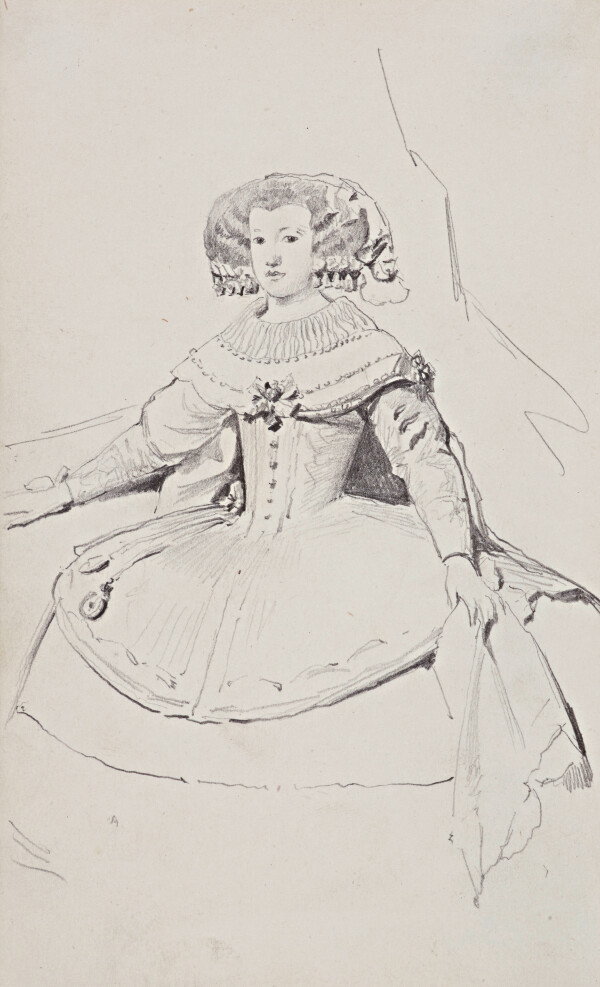
Gustav Klimt: Copy after the portrait of the Infanta Maria Theresa by Velázquez, circa 1883, Leopold Museum
© Leopold Museum, Vienna
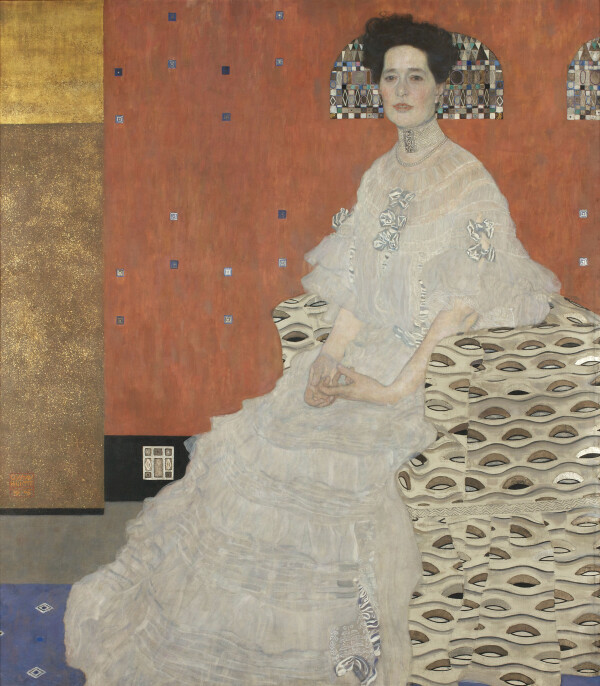
Gustav Klimt: Portrait of Fritza Riedler, 1906, Österreichische Galerie Belvedere
© Belvedere, Vienna
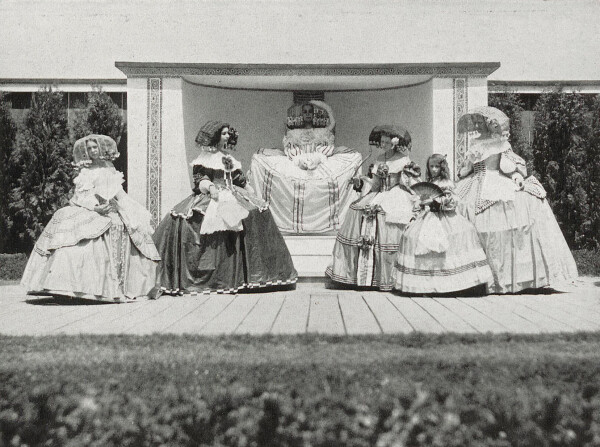
Garden Theater of the Vienna Art Show 1908, scene from "The Infanta's Birthday", in: Deutsche Kunst und Dekoration, Band 23 (1908/09).
© Heidelberg University Library
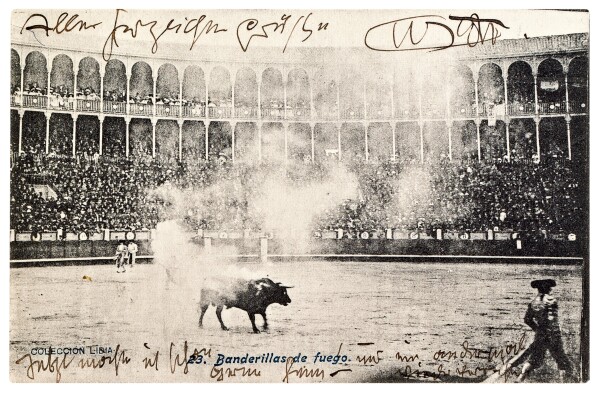
Gustav Klimt: Picture postcard from Gustav Klimt in Madrid to Emilie Flöge in Vienna, 10/27/1909, Leopold Privatsammlung
© Leopold Museum, Vienna
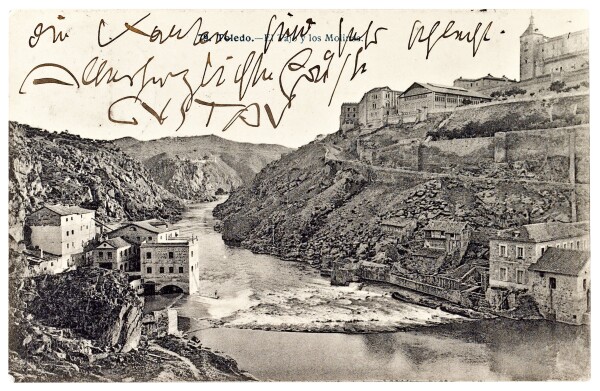
Gustav Klimt: Picture postcard from Gustav Klimt in Toledo to Emilie Flöge in Vienna, 10/28/1909, Leopold Privatsammlung
© Leopold Museum, Vienna
In the autumn of 1909, Gustav Klimt and Carl Moll embarked on a trip to Paris. They combined this journey with a several-day study trip to Spain. Along with Diego Velázquez, whom Klimt had had the opportunity to study already in Vienna, the master of Jugendstil was most impressed with the art of El Greco he encountered in Spain.
Klimt and Spanish Painting
Klimt first came into contact with Spanish art towards the end of his training at the Imperial-Royal School of Arts and Crafts. The two works on paper, which likely date from around 1883, Copy after the Portrait of the Infanta Maria Teresa (Leopold Museum, Vienna, S 1989 : 3270) and Copy after a Portrait of the Infante Baltasar Carlos (Archiv der Universität für angewandte Kunst, Vienna, S 1989: 3272), which presumably originated from a sketchbook, illustrate Klimt’s study of those works by Diego Velázquez which used to be owned by the Austrian imperial family, and were later incorporated into the collection of the Kunsthistorisches Museum. Ten years later, the artist explored the art of Velázquez once more. The hyper-realistic rendering of the jewelry in the painting Portrait of a Woman (c. 1893/94, private collection) is reminiscent of the emphasis on material textures in the works of the Spanish master.
At the beginning of 1903, the exhibition “Die Entwicklung des Impressionismus in Malerei und Plastik” [“The Development of Impressionism in Painting and Sculpture”] at the Vienna Secession afforded Klimt the opportunity to study works by the Spanish artists El Greco, Diego Velázquez and Francisco de Goya. In 1906, the Jugendstil master encountered the art of Velázquez once again when he visited the National Gallery in London during a trip to England. The exponent of the Spanish Siglo de Oro likely held a certain fascination for Klimt who, according to Erich Lederer, once postulated: “There are only two painters: Velázquez and myself!” That year, Klimt created the painting Portrait of Fritza Riedler (1906, Österreichische Galerie Belvedere, Vienna), which once again reveals the portrait of the Spanish Infanta Maria Teresa as its inspiration.
As head of Galerie Miethke, Carl Moll organized an exhibition on Francisco de Goya in the spring of 1908. In the foreword of the exhibition’s catalogue, he anticipated the trip he would take with Klimt the following year:
“Anyone who wants to judge modern painting must be familiar with the rich collections of Paris, must travel further to Spain to uncover many a root of this modern style of painting […].”
Spanish stylistic features were also present at the exhibition “Kunstschau Wien,” held that year, as illustrated by the play Der Geburtstag der Infantin [The Infanta’s Birthday] which was performed at the exhibition’s garden theater. The costumes and portrayals, reminiscent of a tableau vivant, clearly recall Velázquez’s portraits of the Spanish royal family. A contrast to this is provided by the dress of the dancer Klimt visualized in the chalk drawing Dancer in a Flamenco Costume, Lower Left: Repetition of the Motif. Study for Judith II (Salome) (1908, Leopold Museum, Vienna, S 1982: 1694). The artist’s orientation on the title-giving Spanish costume is unmistakable.
“Spain is a Peculiar Country!”
On 24th October 1909, Gustav Klimt embarked on the 26-hour journey from Paris to Madrid. He stayed with Carl Moll in the Spanish capital and in Toledo until the last day in October. In several picture postcards sent to Emilie Flöge, Klimt described his ambivalent attitude towards Spain and its art. He perceived it as “a strange country,” on the one hand “bleak – desolate – monotonous” and on the other “interesting – hard – harsh in its beauty!”
During his stay in Madrid, Klimt visited the palace and monastery complex El Escorial, situated close to the capital, as well as several private collections, including that of the Dukes of Alba. The Museo del Prado, too, was part of the obligatory program. While Klimt was taken with the museum as such, he was disillusioned by the Velázquez works on display. Madrid itself was also a “grave disappointment” to him, as “neither the buildings nor the people” impressed him. Klimt and Moll looked in vain for the “beautiful Spanish lady,” and even the Spanish nightlife failed to fascinate the genius painter. In a picture postcard Moll wrote to Josef Hoffmann, Klimt added tersely: “Spain and Moll entirely unsuited to ‘night-time adventures.’ Gustav.” It wasn’t until his visit to Toledo that Klimt adopted a more positive attitude towards Spain.
The patron, art collector and founder of the Museo del Greco, Don Benigno de la Vega-Inclán y Flaquer, accompanied the Austrian travelers on their tour through this medieval city. He guided them around the small estate with a garden, believed to have been El Greco’s residence, and showed them his extensive collection of works by this master. “Toledo is magnificent!” – “Greco is also splendid!” Klimt enthusiastically wrote to his confidante Emilie Flöge. Klimt’s fascination with the art of the Spanish master anticipated a veritable El Greco mania, which broke out the following year in German-speaking countries. This wave of enthusiasm was prompted primarily by the publication Spanische Reise [Spanish Journey], written by the art historian Julius Meier-Graefe, who regarded El Greco as one of the most important and ground-breaking artists.
In early November, Klimt and Moll embarked on their return journey to France. His stay in Spain having come to an end, Klimt wrote to Emilie with some relief: “7 pm farewell to Spain – am glad!”
Literature and sources
- Ausstellungskatalog »Francisco José de Goya y Lucientes 1746 - 1828«. digitale-bibliothek.belvedere.at/viewer/image/1433945592734/1/ (04/08/2020), S. 5.
- Ausstellungskatalog »Die Entwicklung des Impressionismus in Malerei und Plastik«. www.secession.nyarc.org/items/show/46 (04/06/2020).
- Alice Strobl (Hg.): Gustav Klimt. Die Zeichnungen, Band IV, 1878–1918, Salzburg 1989, S. 30-32.
- Franz Smola: Das Erlebnis Toledo, 1909, in: Tobias G. Natter, Franz Smola, Peter Weinhäupl (Hg.): Klimt persönlich. Bilder – Briefe – Einblicke, Ausst.-Kat., Leopold Museum (Vienna), 24.02.2012–27.08.2012, Vienna 2012, S. 241-245.
- Christian M. Nebehay: Gustav Klimt. Sein Leben nach zeitgenössischen Berichten und Quellen, Vienna 1969, S. 298.
- Ansichtskarte von Carl Moll und Gustav Klimt in Toledo an Josef Hoffmann in Wien (presumably 10/23/1909).
- Ansichtskarte von Gustav Klimt auf der Fahrt von Paris nach Madrid an Emilie Flöge in Wien, 6. Karte (Nachts) (10/24/1909). RL 2778, .
- Ansichtskarte von Gustav Klimt in Spanien an Emilie Flöge in Wien, 1. Karte (25.10.1909). RL 2779, .
- Ansichtskarte von Gustav Klimt in Toledo an Emilie Flöge in Wien, 2. Karte (28.10.1909). RL 2792, .
- Ansichtskarte von Gustav Klimt in Toledo an Emilie Flöge in Wien, 3. Karte (28.10.1909). RL 2793, .
- Ansichtskarte von Gustav Klimt in Madrid an Emilie Flöge in Wien, 1. Karte (10/30/1909). RL 2797, .
- Brief mit Kuvert von Gustav Klimt in Paris an Emilie Flöge in Wien (01.11.1909). RL 2805, .
- Christian M. Nebehay (Hg.): Gustav Klimt. Dokumentation, Vienna 1969, S. 507.
- Wolfgang Georg Fischer: Liebe Emilie! Klimt schreibt an Emilie Flöge, in: Tobias G. Natter, Franz Smola, Peter Weinhäupl (Hg.): Klimt persönlich. Bilder – Briefe – Einblicke, Ausst.-Kat., Leopold Museum (Vienna), 24.02.2012–27.08.2012, Vienna 2012, S. 47-50.
- Helena Pereña: »Greco-Manie« in Wien um 1910? Antworten von Oppenheimer, Kokoschka und Schiele, in: Johann Thomas Ambrózy, Carla Carmona Escalera, Sandra Tretter, Eva Werth (Hg.): Egon Schiele Jahrbuch, Band II/III, Vienna 2012.

